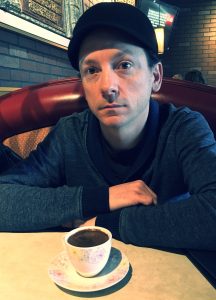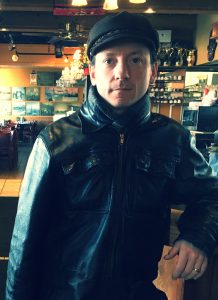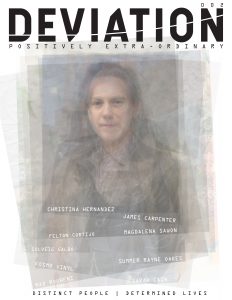Bret Figura: Old Soul, New Emotion

Photo by Carole Sharwarko @sharwarko
By Carole Sharwarko
Bret Figura’s home is one of those houses where the doorbell is always ringing, where neighborhood kids come over to see who’s around to play, and where a huge extended family gathers to celebrate holidays, birthdays and nothing in particular, too.
Bret seems to thrive off the energy, laughing easily and taking all the interruptions in stride. With a small, wiry frame and hair to match, he sits cross-legged on a stuffed chair covered with fabric in a musical instrument motif. His pug, Stella, snores impressively loudly on the chair behind him while Nanook, a giant white puffball of a dog, naps near his feet.
Downstairs, his wife Danielle is working on clients in her home salon, where she does a swift business cutting, coloring and designing hair. The couple’s two older sons, Andrew, 11, and Spencer, 9, are at friends’ houses while their youngest, Max, 6, plays video games upstairs with a neighbor friend.
Bret explains that a group of family is coming over in a few hours to prepare food for an upcoming holiday spread, but he’s made time for our interview. Ever since he started working as a graphic designer at a community college he’s got a great schedule with plenty of time off.
Before the job in academia, Bret worked as a graphic designer across many media, spending more than a decade designing at a daily newspaper and four years for a health magazine company. In college, he studied fine art and percussion and over the years he’s become an accomplished semi-professional drummer.
Now Bret has a job that allows him to make a living, pursue passion projects, play drums, and spend time with family and friends. Basically, Bret Figura is feeling pretty blessed right now.
Your parents have a background in music and I know they were in a band together for a short time. Were they particularly artistic?
“My mom would play guitar and sing around the house, usually in a rehearsal fashion rather than performing. She would go into a room and sing a bit and play. My mom could also draw well, so she would do portraiture here and there for fun, or they were gifts for family. She was a visual artist, not in the abstract way, but in a very practical, realistic way. Oftentimes, when we were complaining that we were bored, she would hand us a paper and pencil and have us draw. She was the kind of mom who made our Halloween costumes. She was very much into papier-mache and sewing. I remember one year she made a Batman costume for me, and another year she made a papier-mache Garfield head for my brother Shawn. She was crafty and had the sensibility to know how to do it and she wouldn’t be afraid to go ahead and dive in. I think parents back then probably did that more than now because they weren’t willing to go out and buy a costume when they could make one for cheaper. My mom was an artist for practicality more than anything.”
What are your first memories of drawing?
“Wow, I probably still have some of that stuff. In fact, I know I do. It was stuff I could easily reference; I was into G.I. Joe, Transformers, Garfield. I would make up little characters, new G.I. Joe and Transformers characters.”
Were they good drawings? Did people comment that you had talent?
“Once I got into school, I had friends who would comment or ask me to draw them something, usually Garfield. I remember one time, my uncle, who is an architect, had some kind words about a G.I. Joe character I drew. My cousins and I would draw goofy cartoons with made-up characters. Mostly it was bathroom humor. (laughs) So I got some recognition and also some people to work with. I got that first sense of working with other people to create something.”
Did you have a sense of that then, or do you just see that in reflection?
“Even back then, there was an excitement about getting together with a few people and making something. We would also do the air band thing and grab an ‘instrument’ and fake our video.”
What artists got you excited as a young person?
“Some of my earliest memories of liking art were of Salvador Dali catching my eye. Before that, it was watching cartoons.”
You actually liked looking at the way things were drawn? Give me an example of something you thought was drawn really cool.
“Yeah, I always loved watching Looney Toons, Tom and Jerry, Chilly Willy, Woody Woodpecker. I was never really emotionally invested in it, but Popeye was one of those cartoons that always gave me a weird feeling. They always had this ominous, darker vibe to them that was kind of weird. Betty Boop cartoons were always really interesting too. Maybe that’s why I like David Lynch’s work, these movies that give you a weird, can’t-put-your-finger-on-it, awkward feeling, but it’s intriguing. In college, I fell in love with Austrian Egon Schiele and German Gustav Klimt. They had this really awesome angular style of drawing people. Instead of the Italian Romanesque, robust human form, the Germans would draw angled, skinny, gaunt forms.”
It sounds like you can describe your aesthetic as kind of grotesque or unsettling.
“At a young age, I saw The Elephant Man. It really freaked the crap out of me. I should not have seen it. What always stuck with me were those industrial segments Lynch throws in as transitions between scenes. I had a reoccurring nightmare of those scenes and for years I couldn’t face watching that movie again. It just scared the daylights out of me. I finally got myself to watch it in college and I thought it was the best movie ever. Being a fan of David Lynch and his other movies, I re-appreciated it for what it really is, not having child’s mind, but seeing it from an adult’s perspective. It put some things in perspective as far as what I like about art.”

Photo by Carole Sharwarko @sharwarko
When I think about you as an artist, one of the things that comes to mind is your collaborative spirit. You very much enjoy connecting with people and connecting people together. Is that a part of your personality that just plays out in the arts, or do you think it’s specific to that area of your life, that you just love connecting creative people and drawing that energy to and fro?
“It’s something I never thought of. It’s just something that brings happiness. It also comes down to my lack of ability to do something completely myself. (laughs) I can’t sit down and write a song and play all the instruments. So, I can’t say it’s something where I’m being completely altruistic. It’s the excitement of getting together and playing with other people, but it’s also this selfish thought that, ‘I can’t make that,’ or ‘I can’t facilitate that,’ or ‘I know someone else who is really great at that, and can do it much better than I can.’ It might be as simple as me needing some writing to go along with an image I’ve created, and you can do that much better than I can. Or on the musical front, I’ll think of a melody but I can’t play that on drums. Then there’s an excitement that comes when you hear it or see it or read it, that thing you created with someone else. Also, getting people together and involved in something who might otherwise not have connected, that’s always great. I get excited about sharing new things with people in general in the arts.”
You might say that you rely on other artists to bring your parts to fruition, but there’s a humanity there. As much as you reflected on the selfish part, (Bret laughs) I would also want you to reflect on the other part, that a lot of people do their artistic pursuits in isolation, or they decide that they’ll just write the melody on their own. Don’t discount that part that allows you to extend yourself that way. Many of us who are artists or want to be artists, we don’t share our art because we’re so afraid of being judged on it.
“Well, there is judgment, and one thing I got over pretty early on is worrying about the judgment and the ego. You can’t be afraid to talk an idea out. It might get used and it might not, but at least you can talk it out and give it a whirl. If it doesn’t work, hopefully you have the sense enough to say, ‘Eh, that doesn’t work,’ and move on.”
Or you have people around you with the sense to tell you it doesn’t work.
“Right, and then you can ditch it or improve it in some way. You allow the other person to add their flavor and improve upon it. It’s a big hurdle to allow yourself to change and to allow someone else to change what you have created. That’s in everyday life. People have problems with allowing change to happen.”
How did you develop that sensibility? Was that bred through study? Was it modeled to you?
“I’ve been thinking about that a lot lately. A lot comes through improvisation, just allowing oneself to be thrown into a situation without a preconceived notion of the outcome. In high school, my second band experience was mostly instrumental, a band called Gowhead. It was melodies that would go off into an open group jam session. Creating music on the spot in front of people, when you might fail, you learn a lot from that.
“After that, I fell into more situations like that and it would get more intense as the level of risk involved in the performance would raise. In college, I joined a jazz quartet that played at a coffeehouse regularly even though I didn’t know the first thing about jazz and I couldn’t really read music. But no one else wanted to take the gig. I lived in a house with all drummers and percussionists and no one wanted to take the gig. I got some great advice from a percussion instructor who said, ‘Never turn down a gig if you are asked, even if you don’t think you can do it because obviously someone thinks you’re up for the challenge and you never know where it’ll lead.’ So I dove in, but it wasn’t out of lack of fear. It was out of ignorance. (laughs)
“I learned how to do improvisation. I started taking gigs where there’s no rehearsal and you just go in and play. You rely on your intuition, your ability, muscle memory, and the bag of tricks you’ve gathered over time to get you through. And knowledge about the fact that you’re going to come out alive on the other end. (laughs) Nothing’s going to hurt.
“Visually and artistically with music, those things relate, greatly. The ability to jump into a painting or a design is just as important. Being able to dive into something and if it doesn’t work, go back to the blank page and start over. Don’t cling to something that’s not working. It’s not always easy, but it gets easier the more you do it.”
Do artists forget to practice? Is that even present in the artistic conversation?
“I don’t think that’s an issue now so much as it was before the new media, digital age. Online, you see tons of practice tips, instructional videos, techniques, compared to when we were young and you had to go get the ‘book’ and read the ‘book.’ All the free tools people have available to them at this point is just amazing. When it comes to practicing, it’s more about wrapping your head around practicing the right way.”
What about not practicing the skill, but practicing the experience of putting your art out there? Actually playing the gig? Do you think artists need to practice sharing their art with others?
“It depends on what your end goal is. There are plenty of people who are happy with creating a thing for themselves and don’t need recognition from people. Me, I need recognition from people. (laughs) I enjoy performance and I enjoy showing work. I don’t fish for compliments. But if you want to have a body of work to share, you can’t wait around for someone to ask you to be in that band or paint a painting or design this thing. You have to go out and get the job. Don’t be afraid to book the gigs. Be the bandleader. Go ahead and create something. With social media you see a breakdown of people – those who just share things and those who are content generators and create something and try to put it out there. Maybe they have a statement with what they’re creating or maybe they just enjoy creating and put it out there.”
You’re a working artist and a driven person, especially when it comes to being a bandleader in your current band, The Real Gone. Why are you willing to do the legwork, being the guy who sends the emails and makes the phone calls and gets the press packet together? Not everyone is willing to do the legwork.
“Yeah, I was the guy not willing to do the legwork for years. (laughs) I went along for the ride, mostly through sheer ignorance. It took years of being in experiences, learning from people how to lead a design situation or a musical situation. It’s because of the people along the way who gave me those leadership skills that I had the confidence to be able to do that.
“Musically, I was not ready to do it until Danielle and I had kids. The newspaper job was just not cutting the mustard financially, so Andrew came along and I thought to myself, ‘I can’t go out and play these gigs for no money, being away from the family. If I’m going to continue to play music, it must be financially rewarding to validate the time away.’ So that’s how The Real Gone came about, being in my first working band making money. Years ago in high school my dad told me to join a wedding band. (laughs) You know, be in your normal band, too, but join a band that makes money. I should have listened back then. I tried at one point when I got home from college, but it didn’t work out. It took having children to have that drive. I can’t just be away for my own self-indulgent purposes. That was the impetus for getting the band going. When I found I was able to go out and book a gig and get everyone in the band $100 for it, I wanted to sustain that. I am worth that. There’s no reason I can’t do that in other situations and keep that same level of professionalism and keep that financial reward, and to have it be personally rewarding as well. And it allows me to be in bands that are more artistically driven and less financially driven.
“Now with the day gig being more financially stable, it allows me the flexibility to say yes to different projects that I wouldn’t have done years ago. The time that it would have taken back then without financial reward wouldn’t make it worth it. I recently left a more artistic band that didn’t play out enough. It was a weekly rehearsal, one day a week away from the family. And then not to be able to share it with an audience often enough made it difficult to justify that time.”
It’s also artistically frustrating when you’re not able to share what you’ve created. You’re not just jamming with your buddies. Nothing against jamming with your buddies, but that’s not what you’re into it for.
“Right, it was original music. It was great stuff and I really liked the material, so it was tough to walk away from. It was someone I wanted to work with for years, so I stuck with him for as long as I could. There are other bands I’m involved in now and we only get together if we book a gig, a few days before for rehearsal. Same thing in freelance design. I used to not say no to anything, but now I only take in what most interests me because the day gig allows me the financial support.”

Photo by Carole Sharwarko @sharwarko
What’s your current freelance design workload?
“Just for friends; I don’t seek out work online. The most recent thing I did was a double vinyl layout. That’s the kind of stuff I’ve always want to do, focus on music-oriented design. When I first graduated school, I thought I would do concert posters and that kind of thing. I never learned silk screening, which I should have done. I did some CD designs, a lot of stuff for the bands I was in, and I didn’t mind being the guy who was relied upon to do that. It was an outlet for me in many ways.
“For my band the Stone City Stragglers, I worked with the lead singer on that whole CD layout. He’s a graphic designer and an illustrator. He let me have the cover photo, which is an old-time truck with a tree growing through it. I’ve always loved industrial things mixed with organic things. I think the rest of the band was just happy that things got created and promoted. (laughs) I didn’t create things specifically for each CD or flyer. I would create things separately and then see what I could combine – a photo paired with a sketch to create this flyer.”
Again, it turned into more functional art.
“Often I just didn’t have the time to design something totally original. The times I did try that, it came out forced. When I would create the good stuff, I was sitting on my lunch break, doodling, or just sitting down to draw at home. And that’s got a better feeling. Better to go through a stack of work that was actually created with some heart rather than drum something up. I’m able to drum something up when I’m playing music…
Literally! Ha, sorry!
“It’s true! To kind of be an actor, to drum up feelings from the past to infuse feeling into the music while I’m playing – that, I’ve practiced how to do. Visually, that’s much harder to do for me. If I was painting, I could get there emotionally and lose myself. But in design or illustration, it’s much harder to get there because you’re trying to communicate a message. You have to focus on it consciously. You have to think about the feeling that’s put behind your work and be practiced at it. For me, it’s much more difficult on the visual side to apply from gut to hand to paper or computer screen. I can get mired in trying to get the idea across. Musically, I have the muscle memory, the technique and the wherewithal that I can just apply the emotion. Artistically, I don’t have the skillset and technical ability that other people might have to apply the feelings through the tool and generate what Van Gogh did, for example. To put the emotion on the canvas, that’s the gift. Plenty of people can do the ‘thing,’ but to the put the emotion behind the thing, that’s the gift.
“Now with digital tools so readily available, how do you get the emotion through in the digital age when you’re not dealing with an analog medium; when you’re not dealing with hand-to-paper? You’re dealing with hand-to-mouse-to-computer. Where does the emotion go? How do you get that through?”
Do you think people are forgetting it?
“Mm-hm. The short answer is yes.” (laughs)
It’s not that it can’t happen; it’s that people are forgetting it or not recognizing it because now everyone can do the “thing.”
“The emotion gets lost in the tool; it gets lost in the gimmick. Not only that, but it’s just plain harder. You’re going through an extra tool that makes it much more difficult to get that emotion across. You have to have the knowledge or wherewithal to create that fake emotion. If I go into Photoshop and make a stroke with my mouse, that’s not direct to paper. You have to have the knowledge and the other tools that will render that emotion properly through the digital world. So, if you’re using a Wacom tablet with a pen, you have to be able to visualize the pressure that your hand is putting on the thing to be able to make that brush stroke look the way you want and express whatever emotion you want to express.”
I imagine it’s a similar challenge as in language translation. You can do a literal translation of a book, but a good translator is able to take in the meaning of a phrase and then “reprogram it” to whatever output is necessary. Do you think that’s even possible in an artistic sense, to be successful in that translation? Is there a program that does that — allows you to translate the brush stroke with different amounts of pressure?
“Yes, it exists, and I’ve seen it in action. This is where the new professionalism comes into play. Everyone’s got the tools, but only some professionals can take these tools and render things emotionally in such a way that it looks like a real painting. You can’t tell it’s digital — well you can, because if you saw it in person you would realize that the texture is missing — but there are different pressure points within a regular brush stroke. I have a friend who does fantastic illustration. He has the skill and the proper tools within Photoshop to render something that has an emotional “it” about it. It’s not this flat thing that’s devoid of that visual emotion behind the tool.
“The thing is, that group of people who can do that successfully is a smaller group than it would be if it were just anyone doing it manually. You could pick up a piece of paper and draw something, and hand it to me, and I could feel that. Then you could go to Photoshop and do the same thing, and you’re not going to be successful. The amateur doesn’t have that emotional voice when diving into that realm.”
You also have to have the complementary skillset within the digital technology to execute it. You could have a wonderful artist that has emotional connection, but no technical skills.
“Right. Look at children’s art created with a marker or crayon, and it’s so visceral. But you can give them a mouse and a design program, and what they produce is just not going to capture you the same way. It’s the same with the visual arts and the musical arts. There’s a reason why you put on Led Zeppelin — you feel it right away. It’s the human hand, connected to a tool, direct to the instrument — hand to drumstick, hand to pick, mic to mouth. In the digital world, you have to go through the digital void and somehow elicit that same emotion, and most of the time it falls flat. Unless you have someone who knows the digital world and has the tools that will render those nuances, it lacks that human connectivity and that emotion, which ultimately detracts from the art. So now you have a bulk of people using all these digital music tools and that’s great, but I’m not feeling it. Whereas you can tell a kid, ‘Slam something out on this drum set,” and it could make you well up with tears. It’s this amateurish thing, but it’s something you can feel because it’s going through those rudimentary instruments rather than going through the digital process. Those nuances and imperfections are what makes it human. Otherwise, you just get this sterilized thing.”
There’s no undo button in the real world. Like Bob Ross said, “There are no mistakes; just make it into a happy tree.” You’re redoing it, but you’re making into a new little happy tree. The undo button is useful, but it’s not particularly soulful.
“Right, and there’s a place for lack of soul and humanity. Certain direct art forms use that to get their message across properly.”
Speaking of lacking soul, that brings me to your current work. I’m just kidding, of course, but you are now working in a much more straightforward design job. Have you found creative outlets in your current role or do you consider yourself a functional designer? What’s the balance there?
“When taking this job, I knew it was not going to be as artistically rewarding than working at the magazine I was at, where we did a lot of interesting stuff conceptually. I was able to use my illustrative skills a lot more there. I knew walking into this job that I probably wouldn’t be doing that type of work as much. There are some posters here and there, but all the other benefits that came along with this job made it worth it. I resigned myself that this is a gig and I can take freelance jobs at home to get the other excitement that I want or need. That was easy to compartmentalize. Also, it helped to realize that the utilitarian design is just as important as anything else, and it’s important to do that well because a lot of people don’t.”
Your current work changes lives in a very real way – whether you can find the class you need or not, that’s real stuff. That kind of design sounds simplistic to some people, but as you and I know, it’s not.
“No, it’s not. We’re still improving on that sort of thing, solving problems of how to create messaging pieces or scheduling pieces that make it easier for people to get involved in education. I’m OK with slinging education. (laughs) I prefer that to being a designer who’s slinging ties or lawnmowers.”
It’s a mission-based job. Your work improves the lives of people. Do you like being able to use your skillset to help others?
“For sure. That’s why I loved working at the newspaper and magazine. It’s content creation that’s utilitarian; it’s not just marketing a product.”

Photo by Carole Sharwarko @sharwarko
It is important to you to foster creativity with your kids?
“I follow the improvisational aspect in letting them lead the way. I take cues from them about what they’re interested in and then foster that. Because you never know what’s going to last with kids, right? (laughs) Give them an outlet to explore, within financial realms. I’m not going to go out and buy a guitar because you want to play guitar right now. But if there’s interest and the finances are available, why not? If they want to draw, we pull out the crayons and paper. Want to paint? Let’s do it.”
You post their artwork pretty regularly on Facebook.
“Yeah, and it’s not fishing for likes. (laughs) It’s mostly because you can’t keep all the stuff your kid creates. If you want a record of it, why not use Facebook as a record-keeping device? Keep it as an album. If people want to enjoy it, they can, but they don’t have to. The kids can look at it when they’re 20. I don’t post everything. We talked about that emotional connection – some things just have that emotion in them, and I save those things.”
What artwork captures your attention these days?
“I still consistently look at posts from Juxtapoz magazine. They label themselves as lowbrow art in a fine art context. Graffiti art, car culture, illustration and things that were not typically let into the fine arts scene, they started to gather themselves together and hold themselves to equals as fine art, or an art into itself. I’ve followed the magazine since 1994 and now I follow them on Facebook.
On Instagram I follow a lot of retro stuff, mostly vintage photography. With the iPhone letting you have a camera all the time, I don’t think younger people realize what a sea change that was for artists. Previously, you’re talking about having a camera on you all times, along with film, which costs money. Then you’d need the knowledge of how to prepare film after it’s shot or pay to have it done. Also, you only have a certain number of shots, so you better know what you’re doing. Now all that’s gone. You have the device on you at all times, and it’s basically free. What a change.
“I look at a lot of old print materials. I follow a couple of public domain sites that repost old illustrations and woodcuts. I like to look more to the past than to contemporary design. I’m always trying to remind myself design-wise what works, rather than looking at a bunch of modern stuff that might be experimental or only work for a certain audience. I’d rather look at something from the 1930s that’s still tried-and-true for a modern audience.”
Get Deviation Issue 002 (Print or Digital)
[fbcomments width="100%" num="10" ]



